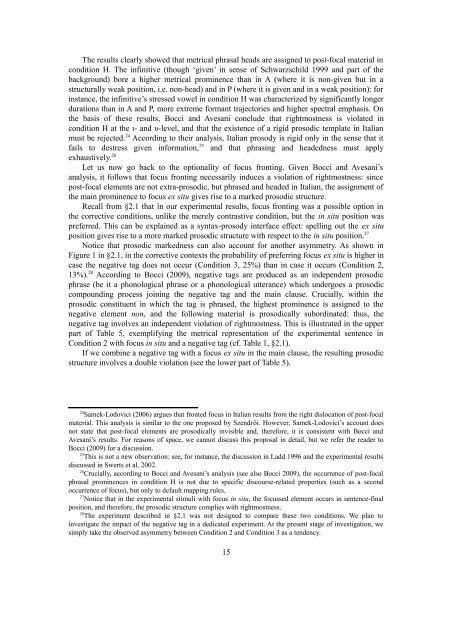Empirical Issues in Syntax and Semantics 9 (EISS 9 ... - CSSP - CNRS
Empirical Issues in Syntax and Semantics 9 (EISS 9 ... - CSSP - CNRS
Empirical Issues in Syntax and Semantics 9 (EISS 9 ... - CSSP - CNRS
You also want an ePaper? Increase the reach of your titles
YUMPU automatically turns print PDFs into web optimized ePapers that Google loves.
The results clearly showed that metrical phrasal heads are assigned to post-focal material <strong>in</strong><br />
condition H. The <strong>in</strong>f<strong>in</strong>itive (though ‘given’ <strong>in</strong> sense of Schwarzschild 1999 <strong>and</strong> part of the<br />
background) bore a higher metrical prom<strong>in</strong>ence than <strong>in</strong> A (where it is non-given but <strong>in</strong> a<br />
structurally weak position, i.e. non-head) <strong>and</strong> <strong>in</strong> P (where it is given <strong>and</strong> <strong>in</strong> a weak position): for<br />
<strong>in</strong>stance, the <strong>in</strong>f<strong>in</strong>itive’s stressed vowel <strong>in</strong> condition H was characterized by significantly longer<br />
durations than <strong>in</strong> A <strong>and</strong> P, more extreme formant trajectories <strong>and</strong> higher spectral emphasis. On<br />
the basis of these results, Bocci <strong>and</strong> Avesani conclude that rightmostness is violated <strong>in</strong><br />
condition H at the ι- <strong>and</strong> υ-level, <strong>and</strong> that the existence of a rigid prosodic template <strong>in</strong> Italian<br />
must be rejected. 24 Accord<strong>in</strong>g to their analysis, Italian prosody is rigid only <strong>in</strong> the sense that it<br />
fails to destress given <strong>in</strong>formation, 25 <strong>and</strong> that phras<strong>in</strong>g <strong>and</strong> headedness must apply<br />
exhaustively. 26<br />
Let us now go back to the optionality of focus front<strong>in</strong>g. Given Bocci <strong>and</strong> Avesani’s<br />
analysis, it follows that focus front<strong>in</strong>g necessarily <strong>in</strong>duces a violation of rightmostness: s<strong>in</strong>ce<br />
post-focal elements are not extra-prosodic, but phrased <strong>and</strong> headed <strong>in</strong> Italian, the assignment of<br />
the ma<strong>in</strong> prom<strong>in</strong>ence to focus ex situ gives rise to a marked prosodic structure.<br />
Recall from §2.1 that <strong>in</strong> our experimental results, focus front<strong>in</strong>g was a possible option <strong>in</strong><br />
the corrective conditions, unlike the merely contrastive condition, but the <strong>in</strong> situ position was<br />
preferred. This can be expla<strong>in</strong>ed as a syntax-prosody <strong>in</strong>terface effect: spell<strong>in</strong>g out the ex situ<br />
position gives rise to a more marked prosodic structure with respect to the <strong>in</strong> situ position. 27<br />
Notice that prosodic markedness can also account for another asymmetry. As shown <strong>in</strong><br />
Figure 1 <strong>in</strong> §2.1, <strong>in</strong> the corrective contexts the probability of preferr<strong>in</strong>g focus ex situ is higher <strong>in</strong><br />
case the negative tag does not occur (Condition 3, 25%) than <strong>in</strong> case it occurs (Condition 2,<br />
13%). 28 Accord<strong>in</strong>g to Bocci (2009), negative tags are produced as an <strong>in</strong>dependent prosodic<br />
phrase (be it a phonological phrase or a phonological utterance) which undergoes a prosodic<br />
compound<strong>in</strong>g process jo<strong>in</strong><strong>in</strong>g the negative tag <strong>and</strong> the ma<strong>in</strong> clause. Crucially, with<strong>in</strong> the<br />
prosodic constituent <strong>in</strong> which the tag is phrased, the highest prom<strong>in</strong>ence is assigned to the<br />
negative element non, <strong>and</strong> the follow<strong>in</strong>g material is prosodically subord<strong>in</strong>ated: thus, the<br />
negative tag <strong>in</strong>volves an <strong>in</strong>dependent violation of rightmostness. This is illustrated <strong>in</strong> the upper<br />
part of Table 5, exemplify<strong>in</strong>g the metrical representation of the experimental sentence <strong>in</strong><br />
Condition 2 with focus <strong>in</strong> situ <strong>and</strong> a negative tag (cf. Table 1, §2.1).<br />
If we comb<strong>in</strong>e a negative tag with a focus ex situ <strong>in</strong> the ma<strong>in</strong> clause, the result<strong>in</strong>g prosodic<br />
structure <strong>in</strong>volves a double violation (see the lower part of Table 5).<br />
24<br />
Samek-Lodovici (2006) argues that fronted focus <strong>in</strong> Italian results from the right dislocation of post-focal<br />
material. This analysis is similar to the one proposed by Szendrői. However, Samek-Lodovici’s account does<br />
not state that post-focal elements are prosodically <strong>in</strong>visible <strong>and</strong>, therefore, it is consistent with Bocci <strong>and</strong><br />
Avesani’s results. For reasons of space, we cannot discuss this proposal <strong>in</strong> detail, but we refer the reader to<br />
Bocci (2009) for a discussion.<br />
25<br />
This is not a new observation: see, for <strong>in</strong>stance, the discussion <strong>in</strong> Ladd 1996 <strong>and</strong> the experimental results<br />
discussed <strong>in</strong> Swerts et al. 2002.<br />
26<br />
Crucially, accord<strong>in</strong>g to Bocci <strong>and</strong> Avesani’s analysis (see also Bocci 2009), the occurrence of post-focal<br />
phrasal prom<strong>in</strong>ences <strong>in</strong> condition H is not due to specific discourse-related properties (such as a second<br />
occurrence of focus), but only to default mapp<strong>in</strong>g rules.<br />
27<br />
Notice that <strong>in</strong> the experimental stimuli with focus <strong>in</strong> situ, the focussed element occurs <strong>in</strong> sentence-f<strong>in</strong>al<br />
position, <strong>and</strong> therefore, the prosodic structure complies with rightmostness.<br />
28<br />
The experiment described <strong>in</strong> §2.1 was not designed to compare these two conditions. We plan to<br />
<strong>in</strong>vestigate the impact of the negative tag <strong>in</strong> a dedicated experiment. At the present stage of <strong>in</strong>vestigation, we<br />
simply take the observed asymmetry between Condition 2 <strong>and</strong> Condition 3 as a tendency.<br />
15











